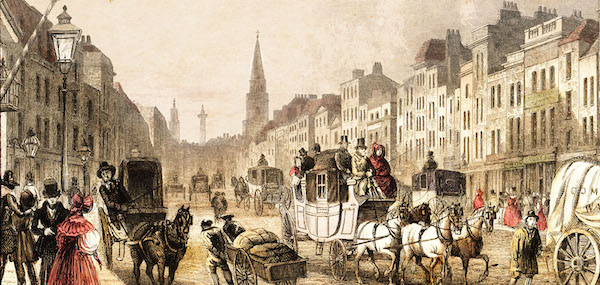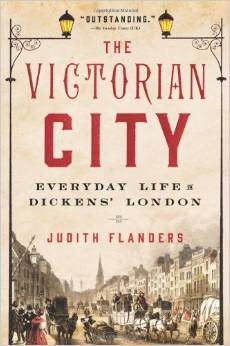80,000 Prostitutes? The Myth of Victorian London's Love Affair with Vice

There are two abiding myths of Victorian Britain. The first is that the Victorians were so prudish they wouldn’t even say ‘trousers,’ and covered their piano legs in pretty pantaloons. (In reality, this bizarre idea was a retrospective creation of the 20th century.) The second myth, to counterpoise the prudery, was that Victorian men were always on the prowl, serviced by tens of thousands of prostitutes instead of their trouser-averse wives.
 Many experts at the time (and
many since) have stated confidently that there were 80,000
prostitutes in London, in a population heading towards 2 million by
mid-century. But it cannot be stated too emphatically that we have no
firm knowledge of the number. First, there is the question, what is a
prostitute? Apart from a woman actively soliciting on the streets or
working in a brothel, does it include a woman living with a man, to
whom she is not married, on a long-term, monogamous basis? A woman
intermittently or regularly given cash by a long-term, or short-term,
partner? A woman whose wages do not entirely support her, or who is
temporarily out of work, who receives financial help from one or more
men? A woman who had sex outside marriage, with no cash element at
all? Many in the nineteenth century regarded all of these women as
prostitutes.
Many experts at the time (and
many since) have stated confidently that there were 80,000
prostitutes in London, in a population heading towards 2 million by
mid-century. But it cannot be stated too emphatically that we have no
firm knowledge of the number. First, there is the question, what is a
prostitute? Apart from a woman actively soliciting on the streets or
working in a brothel, does it include a woman living with a man, to
whom she is not married, on a long-term, monogamous basis? A woman
intermittently or regularly given cash by a long-term, or short-term,
partner? A woman whose wages do not entirely support her, or who is
temporarily out of work, who receives financial help from one or more
men? A woman who had sex outside marriage, with no cash element at
all? Many in the nineteenth century regarded all of these women as
prostitutes.
In 1791, a police-magistrate estimated (and he used the word ‘estimate,’ and also ‘conjecture’) that there were 50,000 prostitutes in London, of whom at least half were unmarried women living with their partners. But shortly this number was taken to as the figure for women being paid for sex by strangers, and simply increased in line with population increases, turning into that mythical 80,000 within a couple of decades.
By 1851, the surgeon William Acton, one of the main contributors to the debate, claimed the figure was now 210,000, calculated by taking as his starting-point the 42,000 illegitimate births that year. These women had ‘taken the first step in prostitution’, and from that he decided that each of them would go on to work as a prostitute for an average of five years: 210,000 women. This despite knowing full well (because he quotes the figure too) that the police had, in 1841, thought there were fewer than 10,000 prostitutes in London.
Another expert, Michael Ryan, the author of Prostitution in London (1839), appeared every bit as innumerate and even more credulous. He started with the famous 80,000 figure, ‘each’ of whom, he stated, had a ‘bully’, or pimp. Each bully, in turn, spent their nights in brothels to ‘assist in robbing, and often in murdering their victims’. So 80,000 murdering pimps, yet only pages before, he cited police reports that listed only one brothel robbery, and no murders. As if that weren’t enough, ‘an enlightened medical gentleman’ had told him that one of London’s rivers had ‘an aqueduct of large dimensions, into which murdered bodies are precipitated by bullies’, from where they could be washed into the Thames.
As this shows, the real problem in writing about prostitution was a lack of direct information. The most important book on London street-life was Henry Mayhew’s London Labour and the London Poor, based on thousands of direct interviews collected in the 1840s by Mayhew himself. But the section for prostitutes was different. The author was a 19-year-old named Bracebridge Hemyng, who had recently left school and was studying law, and was almost entirely a historical and geographical summary, or was based on material provided by reform bodies aimed at eradicating the trade, instead of interviews with the participants which reproduced their life stories and experiences in their own words.
Acton was similarly distant. He had counted, he said, 185 in one walk down the streets. His route had taken him through the centre of the red-light district, so he may have passed many working women, possibly even 185. But short of accosting each one, it is hard to know how he knew the 185 he counted were sex-workers. Some may have offered their services, of course. It is just as likely, though, that Acton made his judgements based on the women’s clothes and manner, or their location: women who dressed or behaved in a way men considered inappropriate, or were in places men thought they should not be, were whores.
One of the few sources we have is an autobiography, My Secret Life, by someone known merely as ‘Walter’, an eleven-volume memoir of, shall we say, a man’s ebullient erotic life. In reality, the book is pornography, and we have no idea if it is based on fact. My own view is that the details of the book are consistent enough to suggest it is basically the autobiography of a middle-class professional man born in the 1820s, who died sometime after 1894, with a heavy overlay of fantasy when it comes to the sex. At any rate, historians rely on Walter for lack of any better material.
Unlike Acton, Walter makes it clear that recognizing a prostitute in the street was not straightforward. Walking down a muddy street, he watched a woman ‘holding her petticoats well up out of the dirt, the common habit of even respectable women...With gay ladies [the polite term for prostitutes] the habit was to hold them up just a little higher.’ But how high was ‘a little higher’? Walter was not sure. He ‘met her eye. She looked at me, but the look was so steady, indifferent, and with so little of the gay woman in her expression, that I could not make up my mind as to whether she was accessible or not.’ He followed her, and when she held up her skirts again, despite knowing he was there, he moved in, ‘saying as I came close, “Will you come with me?” ’ It was only when she agreed that he could be certain. From this, it appears that those who saw streets filled with prostitutes really just saw streets filled with women.
If prostitutes could be identified only when they were approached, then by extension, any woman in the streets might be assumed to be a prostitute. A lithograph of 1865 showed a clergyman handing an improving tract to a fashionably dressed woman, who merely replies, ‘Bless me, Sir...I am not a social evil, I’m only waiting for a bus.’